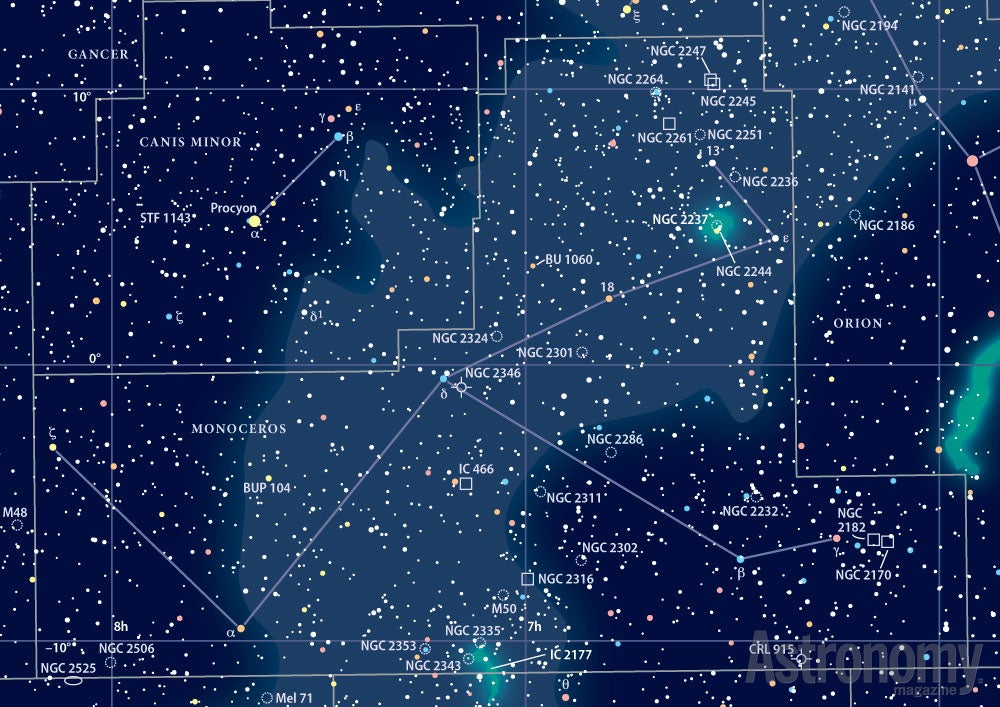Targets for January 22–29, 2015
Small telescope: Sirius
Small telescope: Open cluster NGC 2244
Large telescope: The Monkey Face Nebula (NGC 2175)
Ready for a challenge?
This week’s first small-telescope target is Sirius B, the companion to the night sky’s brightest star, Alpha (α) Canis Majoris. American telescope-maker Alvin Graham Clark discovered that Sirius was a double star in 1862 while testing an 18-inch lens at the Dearborn Observatory in Illinois.
At times, Sirius is a nearly impossible binary star to split. Currently, the gap between the two stars is widening as they rotate around each other. It won’t start to close until 2025. By then, 11″ will lie between Sirius A and Sirius B, also known as the Pup (because Sirius is the Dog Star). After that, the separation will close until 2043, when it will measure only 2.5″.
To spot Sirius B, you’ll need a 4-inch or larger telescope and terrific seeing at your site. Let Sirius get to the meridian — the imaginary line that passes from north to south through the overhead point. You need every advantage to split this pair, so look through the least amount of air.
It’s also a good idea to be familiar with the separation of Sirius A and B. For that, look to a double star that’s easier to split — Rigel (Beta [β] Orionis). The separation between Rigel A and B is approximately 9″, the same as Sirius A and B. Here’s the difference, however: Rigel A is 480 times as bright as Rigel B. Sirius A, on the other hand, is 10,000 times as bright as Sirius B. The brilliance of the primary star makes seeing the B component difficult. To ensure success, crank up the power. I use no less than a magnification of 250x to attempt to separate the Pup from the brilliant primary.
The common name Sirius comes from the Greek word meaning “sparkling” or “scorching.” Richard Hinckley Allen, writing in Star Names and Their Meanings, attributes this star’s name to the Greek poet Hesiod, who lived in the latter half of the eighth century B.C.
Admiral William Henry Smyth, who in 1844 authored one of the great observing guides, A Cycle of Celestial Objects, offers an alternative explanation. He writes that the term is from Siris, an ancient name of the Nile. When this star became visible to the Egyptians and Ethiopians, rising just before the Sun, their year commenced, and with it the annual Nile flood. They attributed that beneficial event to the influence of the beautiful star, so some worshiped it as the god Sothis, and others Osiris.
A bright star group
This week’s second small-telescope object is open cluster NGC 2244 in Monoceros. It’s also known as Caldwell 50, the 50th entry on Sir Patrick Moore’s 109 choices of great celestial objects that didn’t make Charles Messier’s list.
NGC 2244 is the open cluster associated with the Rosette Nebula (NGC 2237–9). It’s big and bright, so you’ll spot it easily with your naked eye from a dark observing site. To find it, point any telescope 9.5° east-southeast of coppery Betelgeuse (Alpha Orionis, the star that marks the right shoulder of Orion the Hunter).
NGC 2244 shines at magnitude 4.8, making it the sky’s 20th-brightest open cluster. It also measures a hefty 23′ across. That means it covers 55 percent as much area as the Full Moon.
Through a 4-inch telescope, you’ll see two dozen bright stars and some 75 fainter ones. A half dozen of the bright stars shine at magnitude 8 or brighter. The cluster’s main portion appears oval and oriented northwest to southeast.
Monkey see …
This week’s large-telescope target is the Monkey Face Nebula in Orion. This celestial smudge combines an emission nebula with an open star cluster some 6,400 light-years away.
Astronomers divide the two into NGC 2174 and NGC 2175, respectively, but you’ll most often see the object referred to as NGC 2175. You’ll spot it in far-northern Orion 2.2 southwest of magnitude 3.3 Propus (Eta [η] Geminorum).
This nebula is a roughly circular object with an indentation on its western side, and it lies in a rich star field. It’s not small, measuring 40′ by 30′. That means it’s 58 percent larger than the Full Moon.
A 4-inch telescope will reveal NGC 2175, but you’ll need a 16-inch or larger scope to see the full extent of its nebulosity. That size instrument will begin to show you the shape that gives NGC 2175 its common name — Monkey Face.
Use a nebula filter such as an Oxygen-III to reduce the glare from nearby stars, which will improve the nebula’s contrast.
Expand your observing at Astronomy.com
StarDome
Check out Astronomy.com’s interactive StarDome to see an accurate map of your sky. This tool will help you locate this week’s targets.
The Sky this Week
Get a daily digest of celestial events coming soon to a sky near you.
Observing Talk
After you listen to the podcast and try to find the objects, be sure to share your observing experience with us by leaving a comment at the blog or in the Reader Forums.











